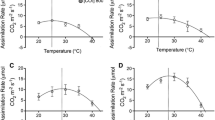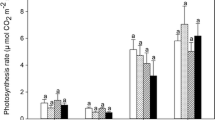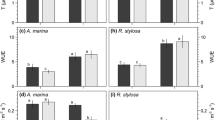Abstract
IPCC predictions indicate an increase in temperatures by 1.5–7°C in some Amazonian regions during the twenty-first century. These changes could disrupt the present distribution patterns of organisms, including wetland plant species. In this work, we determined in microcosms the effects of scenarios combining elevated temperature and atmospheric CO2 concentration on the germination and initial growth of the arborescent Amazonian aquatic macrophyte Montrichardia arborescens. Seeds were germinated, and seedlings produced were monitored over a 5-month period in four microcosms: Control: ambient temperature and CO2 level; Mild: Control + 1.5°C and + 200 ppm CO2; intermediate: control + 2.5°C and + 400 ppm CO2; Extreme: Control + 4.5°C and + 850 ppm of CO2. Rapid light response curves and Fv/Fm values taken in seedlings showed a decrease in electron transportation rate with CO2 and temperature elevation. Mild and Intermediate treatments stimulated biomass production; Extreme treatment and Control produced similar results. The severe climatic changes expected in the future may negatively influence carbon accumulation in M. arborescens. Since aquatic macrophytes in Amazonian wetlands and wetlands worldwide are key plant species, further studies are needed to predict their fate in a global change perspective.




Similar content being viewed by others
References
Aidar, M. P. M., C. A. Martinez, A. C. Costa, P. M. F. Costa, S. M. C. Dietrich & M. S. Buckeridge, 2002. Effect of atmospheric CO2 enrichment on the establishment of seedlings of jatobá, Hymenaea courbaril L. Biota Neotropica 2: 1–10.
Ainsworth, E. A., P. A. Davey, C. J. Bernacchi, O. C. Dermody, E. A. Heaton, D. J. Moore & S. P. Long, 2002. A meta-analysis of elevated [CO2] effects on soybean (Glycine max) physiology, growth and yield. Global Change Biology 8: 695–709.
Allen, S. G., S. B. Idso & B. A. Kimball, 1990. Interactive effects of CO2 and environment on net photosynthesis of water-lily. Agriculture, Ecosystems & Environment 30: 81–88.
Baker, J. T., L. H. Jr & K. J. Boote Allen, 1990. Growth and yield responses of rice to carbon dioxide concentration. Journal of Agricultural Science 115: 313–320.
Bazzaz, F. A., 1990. The response of natural ecosystems to the rising global CO2 levels. Annual Review of Ecology and Systematic 21: 67–96.
Beer, S., M. Björk, R. Gademann & P. J. Ralph, 2001. Measurement of photosynthesis in seagrasses. In Short, F. T. & R. Coles (eds), Global Seagrass Research Methods. Elsevier Publishers, Amsterdam: 183–198.
Bolhár-Nordenkampf, H. R. & M. Götzl, 1992. Chlorophyllfluoreszenz als Indikator der mit Seehöhe zunehmenden Streßbelastung von Fichtennadeln. FBVA Berichte Schriftenreihe der Forstlichen Bundesveranstaltungen 67: 119–131.
Bowes, G., 1993. Facing the inevitable: plants and increasing atmospheric CO2. Annual Review of Plant Physiology and Plant Molecular Biology 44: 309–332.
Bowes, G., 1996. Photosynthetic responses to changing atmospheric carbon dioxside concentration. In Baker, N. R. (ed.), Photosynthesis and the Environment. Kluwer Academic Publisher, Dordrecht: 387–407.
Carvalho, N. M. & J. Nakagawa, 2000. Sementes: Ciência, Tecnologia e Produção. FUNEP, Jaboticabal: 588.
Chen, D. X., M. B. Coughenour, D. Eberts & J. S. Thullen, 1994. Interactive effects of CO2 enrichment and temperature on the growth of dioecious Hydrilla verticillata. Environmental and Experimental Botany 34: 345–353.
Cochrane, M. A. & W. F. Laurance, 2002. Fire as a large-scale edge effect in Amazonian forests. Journal of Tropical Ecology 18: 311–325.
De Simone, O., E. Müller, W. J. Junk & W. Schmidt, 2002. Adaptations of Central Amazon tree species to prolonged flooding: root morphology and leaf longevity. Plant Biology 4: 515–522.
Edwards, A. J., 1995. Impact of climatic change on coral reefs, mangroves, and tropical seagrass ecosystems. In Eisma, D. (ed.), Climate Change: impact on Coastal Habitation. CRC Press, Boca Raton: 209–234.
Grotenhuis, T. P. & B. Bugbee, 1997. Super-optimal CO2 reduces seed yield but not vegetative growth in wheat. Crop Science 37: 1215–1222.
Hartz-Rubin, J. S. & E. H. DeLucia, 2001. Canopy development of a model herbaceous community exposed to elevated atmospheric CO2 and soil nutrients. Physiologia Plantarum 113: 258–266.
Hess, L. L., J. M. Melack, E. M. Novo, C. C. Barbosa & M. Gastil, 2003. Dual-season mapping of wetland inundation and vegetation for the central Amazon basin. Remote Sensing of Environment 87: 404–428.
Idso, S. B., B. A. Kimball, M. G. Anderson & J. R. Mauney, 1987. Effects of atmospheric CO2 enrichment on plant growth: the interactive role of air temperature. Agriculture, Ecosystems & Environment 20: 1–10.
IPCC, 2007: Climate Change 2007: synthesis report. Contribution of Working Groups I, II and III to the Fourth Assessment Report of the Intergovernmental Panel on Climate Change. Core Writing Team, Pachauri, R. K & A. Reisinger. (eds), IPCC, Geneva.
IPCC, 2013: Climate change 2013: The physical science basis. In Stocker T. F, D. Qin, G. K. Plattner, M. Tignor, S. K. Allen, J. Boschung, A. Nauels, Y. Xia, V. Bex & P. M. Midgley (eds), Contribution of Working Group I to the Fifth Assessment Report of the Intergovernmental Panel on Climate change. Cambridge University Press, Cambridge, New York
Jenkins, G., R. Betts, M. Collins, D. Griggs, J. Lowe & R. Wood, 2005. Stabilizing climate to avoid dangerous climate change—a summary of relevant research at the Hadley Centre: Department for Environment Food a Rural Affairs, Met Office Hadley Centre, Exeter: 16
Junk, W. J. & C. Howard-Williams, 1984. Ecology of aquatic macrophytes in Amazonia. In Sioli, H (ed.), The Amazon: limnology and Landscape Ecology of a Mighty Tropical River and its Basin. Dr. W. Junk Publishers, Dordrecht 10: 269–293.
Junk, W. J. & M. T. F. Piedade, 1997. Plant life in the floodplain with special reference to herbaceous plants. In Junk, W. J. (ed.), The Central Amazon Floodplain. Springer, Berlin: 147–185.
Junk, W. J. & M. T. F. Piedade, 1993. Biomass and primary production of herbaceous plants communities in the Amazon floodplain. Hydrobiologia 263: 155–162.
Junk, W. J., P. B. Bayley & R. E. Sparks, 1989. The flood pulse concept in river-floodplain systems. Canadian Special Publication of Fisheries and Aquatic Sciences 106: 110–127.
Khurana, E. & J. S. Singh, 2001. Ecology of seed and seedling growth for conservation and restauration of tropical dry forest: a review. Conservation Biology 28: 39–52.
Koch, M. S., S. A. Schopmeyer, C. Kyhn-Hansen, C. J. Madden & J. S. Peters, 2007. Tropical seagrass species tolerance to hypersalinity stress. Aquatic Botany 86: 14–24.
Krause, G. H. & E. Weis, 1991. Chlorophyll fluorescence and photosynthesis: The basics. Annual Review of Plant Biology 42: 313–349.
Labouriau, L. G., 1983. A germinação das sementes. Organização dos Estados Americanos. Programa Regional de Desenvolvimento Científico e Tecnológico. Série de Biologia. Monografia 24.
Lewis, S. L., P. M. Brando, O. L. Phillips, G. M. van der Heijden & D. Nepstad, 2011. The 2010 Amazon drought. Science 331: 554.
Lopes, A., P. Parolin & M. T. F. Piedade, 2015. Morphological and physiological traits of aquatic macrophytes respond to water chemistry in the Amazon Basin: an example of the genus Montrichardia Crueg (Araceae). Hydrobiologia. doi:10.1007/s10750-015-2431-x.
Lopes, A., F. Wittmann, J. Schöngart & M. T. F. Piedade, 2014. Herbáceas aquáticas em seis igapós na amazônia central: composição e diversidade de gêneros. Revista Geográfica Acadêmica 8: 5–17.
Maguire, J. D., 1962. Speed of germination-aid in selection and evaluation of seedling emergence and vigour. Crop Science 2: 176–177.
Malhi, Y., L. E. O. Aragão, D. B. Metcalfe, R. Paiva, C. A. Quesada, S. Almeida & L. M. Teixeira, 2009a. Comprehensive assessment of carbon productivity, allocation and storage in three Amazonian forests. Global Change Biology 15: 1255–1274.
Malhi, Y., L. E. O. Aragão, D. Galbraith, C. Huntingford, R. Fisher, P. Zelazowski & P. Meir, 2009b. Exploring the likelihood and mechanism of a climate-change-induced dieback of the Amazon rainforest. Proceedings of the National Academy of Sciences 106: 20610–20615.
Maxwell, K. & G. N. Johnson, 2000. Chlorophyll fluorescence-a practical guide. Journal of Experimental Botany 5: 659–668.
Morison, J. & D. Lawlor, 1999. Interactions between increasing CO2 concentration and temperature on plant growth. Plant, Cell and Environment 44: 659–682.
Nobre, C. A., G. Sampaio & L. Salazar, 2007. Mudanças climáticas e Amazônia. Ciência e Cultura 59: 22–27.
Norby, R. J., 1994. Issues and perspectives for investigating root responses to elevated atmospheric carbon dioxide. Plant and Soil 165: 9–20.
Nordenkampf, H. R. & G. Öquist, 1993. Chlorophyll fluorescence as a tool in photosynthesis research. In Hall, D. O., J. M. O. Scurlock, H. R. Nordenkampf, R. C. Leegood & S. P. Long (eds), Photosynthesis and Production in a Changing Environment. Chapman and Hall, London: 193–206.
Ojala, A., P. Kankaala & T. Tulonen, 2002. Growth response of Equisetum fluviatile to elevated CO2 and temperature. Environmental and Experimental Botany 47: 157–171.
Oyama, M. D. & C. A. Nobre, 1999. A new climate-vegetation equilibrium state for tropical South America. Geophysical Research Letters 30: 2199–2203.
Parolin, P., 2001. Morphological and physiological adjustments to waterlogging and drought in seedlings of Amazonian floodplain trees. Oecologia 128: 326–335.
Pepper, W. J., W. Barbour, A. Sankovski & B. Braaz, 1998. No-policy greenhouse gas emission scenarios: revisiting IPCC 1992. Environmental Science & Policy 1: 289–311.
Perez-Garcia, F. & M. E. Gonzalez-Benito, 2006. Seed germination of five Helianthemum species: Effect of temperature and presowing treatments. Journal of Arid Environments 65: 688–693.
Piedade, M. T. F. & W. J. Junk, 2000. Natural herbaceous plant communities in the Amazon floodplains and their use. In Junk, W. J., J. Ohly, M. T. F. Piedade & M. G. M. Soares (eds), The Central Amazon Floodplain: actual Use and Options for a Sustainable Management. Backhuys Publishers, Leiden: 269–290.
Piedade, M. T. F., W. Junk, S. A. D’Ângelo, F. Wittmann, J. Schöngart, K. M. D. N. Barbosa & A. Lopes, 2010. Aquatic herbaceous plants of the Amazon floodplains: state of the art and research needed. Acta Limnologica Brasiliensia 22: 165–178.
Piedade, M. T. F., J. Schöngart, F. Wittmann, P. Parolin & W. J. Junk, 2013. Impactos da inundação e seca na vegetação de áreas alagáveis amazônicas. In Borma, L. S. & C. Nobre (eds), Secas na Amazônia: causas e Consequências. Oficina de Textos, São Paulo: 268–305.
Piedade, M. T. F., M. Worbes & W. J. Junk, 2001. Geo-ecological controls on elemental fluxes in communities of higher plants in Amazonian floodplains. In McClain, M. E., R. L. Victoria & J. Richey (eds), The Biogeochemistry of the Amazon Basin. Oxford University Press, Oxford: 209–233.
Poorter, H., 1993. Interspecific variation in the growth reduction to long-term elevated CO2 in winter wheat. Vegetatio 104(105): 77–97.
Rawson, H. M., 1992. Plant responses to temperature under conditions of elevated CO2. Australian Journal of Botany 40: 473–490.
Reddy, V. R., K. R. Reddy & H. F. Hodges, 1995. Carbon-dioxide enrichment and temperature effects on cotton canopy photosynthesis, transpiration, and water-use efficiency. Field Crops Research 41: 13–23.
Rogers, H. H., W. W. Heck & A. S. Heagle, 1983. A field technique for the study of plant responses to elevated carbon dioxide concentrations. Journal of the Air Pollution Control Association 33: 42–44.
Schimel, D., I. G. Enting, M. Heimann, T. M. L. Wigley, D. Raynaud, D. Alves & U. Siegenthaler, 2000. CO2 and the carbon cycle (extracted from the intergovernmental panel on climate change (IPCC) report, “climate change, 1994”. In Wigley, T. M. L. & D. S. Schimel (eds), The Carbon Cycle. Cambridge University Press, Cambridge: 1–37.
Schmidt, L., 2007. Tropical Forest Seed. DFSC, Dinamarca: 421.
Schreiber, U., R. Gademann, P. J. Ralph & A. W. D. Larkum, 1997. Assessment of photosynthetic performance of Prochloron in Lissoclinum patella by in situ and in hospite chlorophyll fluorescence measurements. Plant and Cell Physiology 38: 945–951.
Short, F. & H. Neckles, 1999. The effects of global climate change on seagrasses. Aquatic Botany 63: 169–196.
Sioli, H., 1984. The Amazon and its main affluents: hydrography, morphology of the river courses, and river types. In The Amazon. Springer, Dordrecht 127–165.
Systat Inc. 2007.SYSTAT 12 SYSTAT Software Inc.
Tian, H., J. M. Mellilo, D. W. Kicklighter, A. D. McGuire, J. V. K. Helfrich, B. Moore & C. J. Vörösmarty, 1998. Effect of interannual climate variability on carbon storage in Amazonian ecosystems. Nature 396: 664–667.
Turcq, B., R. C. Cordeiro, A. Sifeddine, F. F. Simoes-Filho, J. J. Abrão, F. B. O. Oliveira, A. O. Silva, J. L. Capitaneo & F. A. K. Lima, 2002. Carbon storage in Amazonia during the LGM: data and uncertainties. Chemosphere 49: 821–835.
Vasconcelos, S. S. D., P. M. Fearnside, P. M. L. D. A. Graça, E. M. Nogueira, L. C. D. Oliveira & E. O. Figueiredo, 2013. Forest fires in southwestern Brazilian Amazonia: estimates of area and potential carbon emissions. Forest Ecology and Management 291: 199–208.
Waldhoff, D., W. Junk, & B. Furch, 2000. Fluorescence measurements as indicator of adaptation strategies in an abundant tree species from central amazonian floodplain forests. In Lieberei, R., H. Bianchi, V. Boehm & C. Reisdorff (eds), Neotropical Ecosystems: proceedings of the German-Brazilian Workshop, Geesthacht: GKSS-Forschungszentrumpp, Hamburg 573–577.
Wang, D., S. A. Heckathorn, X. Wang & S. M. Philpott, 2012. A meta-analysis of plant physiological and growth responses to temperature and elevated CO2. Oecologia 169: 1–13.
Wetzel, R. G. & J. B. Grace, 1983. Aquatic plant communities. In Lemon, E. R. (ed.), CO2 and Plants: the Response of Plants to Rising Levels of Atmospheric Carbon Dioxide. AAAS Selected Symposium 83, Boulder, Colorado 223–280.
Wheeler, T. R., G. Batts, R. Ellis, P. Hadley & J. Morison, 1996. Growth and yield of winter wheat (Triticum aestivum) crops in response to CO2 and temperature. The Journal of Agricultural Science 127: 37–48.
White, A. J. & C. Critchley, 1999. Rapid light curves: a new fluorescence method to assess the state of the photosynthetic apparatus. Photosynthesis Research 59: 63–72.
Acknowledgments
This work was supported by INCT ADAPTA—Brazilian Ministry of Science, Technology and Innovation (CNPq/FAPEAM), Universal CNPq (14/2009; 14/2011), PELD MAUA (CNPq/FAPEAM) and FAPEAM EDITAL N. 017/2014—FIXAM/AM Nº Processo: 062.01174/2015 to Dr. Aline Lopes. The authors thank Conselho Nacional de Desenvolvimento Científico e Tecnológico (CNPq) for the Doctorate Grant awarded to Aline Lopes and MAUA Research Group, Laboratório de Ecofisiologia e Evolução (LEEM) for logistical and technical support. Dr. A. Leyva helped with English editing of the manuscript.
Author information
Authors and Affiliations
Corresponding author
Additional information
We dedicate this manuscript to the memory of Dra. Mônica Elisa Bleich a great and beloved colleague from the MAUA Group who left us early and suddenly.
Guest editors: Helmut Habersack & Roswitha Samek / Multifunctionality of large rivers
Rights and permissions
About this article
Cite this article
Lopes, A., Ferreira, A.B., Pantoja, P.O. et al. Combined effect of elevated CO2 level and temperature on germination and initial growth of Montrichardia arborescens (L.) Schott (Araceae): a microcosm experiment. Hydrobiologia 814, 19–30 (2018). https://doi.org/10.1007/s10750-015-2598-1
Received:
Revised:
Accepted:
Published:
Issue Date:
DOI: https://doi.org/10.1007/s10750-015-2598-1




